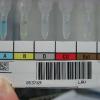Reputation Activity
-
 SMILLER got a reaction from Dansket in Direct entry of manual testing results into LIS
SMILLER got a reaction from Dansket in Direct entry of manual testing results into LIS
We went through this a few years ago. The problem with any kind of written worksheet is that it becomes your primary record -- the computer entry is secondary. -- resulting in both sets of records must be retained. When results are directly entered into the computer, almost all written testing records are not needed.
Scott
-
 SMILLER got a reaction from David Saikin in Direct entry of manual testing results into LIS
SMILLER got a reaction from David Saikin in Direct entry of manual testing results into LIS
We went through this a few years ago. The problem with any kind of written worksheet is that it becomes your primary record -- the computer entry is secondary. -- resulting in both sets of records must be retained. When results are directly entered into the computer, almost all written testing records are not needed.
Scott
-
 SMILLER got a reaction from David Saikin in What in your MTP?
SMILLER got a reaction from David Saikin in What in your MTP?
Agree with Ward's points, above. Any change in policy will involve discussion with ER, Surgery, etc. that includes education once a decision is made.
When we became a level 2 truma center a few years ago, we had a rather elaborate MTP process that included things like Coag and CBC results.
We have two different orders for emergent situations: An "Initial Resusitation Cooler" order (2 RBCs, 2FFP), and an "MTP Protocol" order (5 RBCs, 5 FFPs, 1 5-pk platelets). We repeat the MTP order until it is called off.
In addition, individual orders for uncross matched products can also be made.
Scott
-
 SMILLER reacted to lpregeno in BLOOD DRAW DURING TRANSFUSION
SMILLER reacted to lpregeno in BLOOD DRAW DURING TRANSFUSION
This is something I found on the CAP website: (For some stupid reason I did not copy the URL.)
From the CAP website:
Optimum timing of post-transfusion phlebotomy is critical for ensuring meaningful laboratory testing results, and medical judgment is required in making this determination. Several factors must be considered, including the type and amount of blood product given, purpose of the test (that is, the question it is intended to answer), and clinical setting.
In general, it is best to perform phlebotomy when the patient’s circulatory system is in homeostasis. A patient who is bleeding or undergoing blood product transfusion, or both, is not in a steady state. Whenever possible, samples for laboratory testing should be postponed until bleeding has stopped and transfusion is complete. One obvious exception to this rule, however, would be the setting of massive transfusion, during which monitoring certain laboratory values, such as cell counts and coagulation parameters, is essential to guide ongoing therapy. Variables such as patient blood volume, cardiac output, renal function, and volume of blood products transfused affect how quickly homeostasis is achieved following transfusion.
For the evaluation of post-transfusion increments in hemoglobin, hematocrit, and platelet counts, a practical approach is to draw blood samples within 10 to 60 minutes after completing transfusion, as this time interval is aimed at measuring peak recovery.1 Results determined from blood samples drawn later than 60 minutes post-transfusion are increasingly affected by confounding conditions, such as splenic sequestration, sepsis, and consumption.1,2 If the intent is to determine the extent of such confounding processes on red cell and platelet counts, one should combine a 10-minute post-transfusion sample with sequential samples drawn at one hour and 24 hours post-transfusion.
Alterations in chemistry test results following transfusion are not usually a concern in the low-volume transfusion setting. However, assay results may be affected for varying periods following transfusion of large amounts of blood products, as seen in massive transfusion, red cell, or plasma exchange—particularly if the recipient has impaired hepatic or renal function. Banked storage of red cells results in elevated plasma levels of hemoglobin, potassium, LDH, and iron in the blood unit that may, particularly in the metabolically impaired patient, be reflected in the post-transfusion laboratory values. In addition, citrate anticoagulant present in blood products may result in transient hypocalcemia in the recipient.3 Therefore, following large-volume transfusions or exchanges, waiting 12 to 24 hours before drawing samples for chemistry assays will provide results that are more reflective of the patient’s underlying metabolic state.
-
 SMILLER reacted to mla in Cardiac surgery and what it means for our blood bank?
SMILLER reacted to mla in Cardiac surgery and what it means for our blood bank?
We have had open heart surgeries here for years. A few years back, anesthesia and one of the heart surgeon got a wild hair to have TEG. It has been a major waste of time and money. We had the results feed live into the OR so that they could see them. The company came in a gave them all instructions on the system and how it could help them determine what blood products they needed. They have never used it to make decisions during surgery. Regardless of the results, if their patient is bleeding, they are going to want plasma, platelets, and possibly cryo. We are currently keeping 1 plt pheresis. 2-4 prepooled (5 cryo/pool) cryoprecipitate in house on the days that we have surgeries. We've started keeping 2 A plasma thawed at all times. Most CABG procedures require few products, Valves Replacements can be bigger users.
-
 SMILLER got a reaction from Ensis01 in AlbaQ-Chek Controls Question
SMILLER got a reaction from Ensis01 in AlbaQ-Chek Controls Question
I would think that the rephrasing was to emphasize that is is the reagent in the vials (not just the vials themselves!) that expires after 7 days. I think it is clear that they are saying they claim the reagent is stable for 7 days after opening. If I were an inspector, I would interpret the new phrase as indicating that the "performance characteristics" end after being "maintained" for 7 days, which would mean that you cannot use a vial after that time.
Scott
-
 SMILLER got a reaction from Ensis01 in Blood on Helicopter
SMILLER got a reaction from Ensis01 in Blood on Helicopter
Agree with the comment above. While the patient is in your chopper with your blood, it's your patient. Somehow you must be be charging for the ride and any other care in flight. And like any unit transferred with a patient to another facility, you will have to follow up to finish the transfusion record.
Scott
-
 SMILLER reacted to tcoyle in FDA Final Guidance Psoralen Platlets
SMILLER reacted to tcoyle in FDA Final Guidance Psoralen Platlets
As far as I know, FDA currently has a draft guidance for pathogen reduced platelets. FDA recently came out with the final regarding bacterial risk and platelets.
You can search for FDA guidance's any time. Copy this link https://www.fda.gov/regulatory-information/search-fda-guidance-documents
-
 SMILLER reacted to Marianne in FDA Final Guidance Psoralen Platlets
SMILLER reacted to Marianne in FDA Final Guidance Psoralen Platlets
The final came out on Sept 20th, no longer a draft. We have 18mths to implement.
Bacterial-Risk-Control-Strategies-for-Blood-Collection-Establishments_09-2019.pdf
-
 SMILLER got a reaction from David Saikin in BLOOD DRAW DURING TRANSFUSION
SMILLER got a reaction from David Saikin in BLOOD DRAW DURING TRANSFUSION
All 'it is written's should be the property of each individual facility, approved by your medical director or pathologist.
Here is one discussion regarding drawing blood specimens and transfusions: https://www.phlebotomy.com/pt-stat/stat0513.html
There are also old threads here in Pathlabtalk on this topic.
Scott
-
 SMILLER reacted to David Saikin in AABB Accreditation
SMILLER reacted to David Saikin in AABB Accreditation
I know of blood banks who have been AABB Assessed and NOT have had to have a CAP blood bank inspection. Both are CLIA deemed status. No need to have both (for Blood Bank).
-
 SMILLER got a reaction from David Saikin in AABB Accreditation
SMILLER got a reaction from David Saikin in AABB Accreditation
In the US, all accrediting agencies must satisfy CLIA, and Blood Bank regs are based on AABB standards. So AABB standards are already in use by JCAHO, CAP, etc.
Scott
-
 SMILLER got a reaction from Malcolm Needs in Picky anti-C?
SMILLER got a reaction from Malcolm Needs in Picky anti-C?
The patient is long gone. But the same method -- manual gel -- was used for both the screening cells and the panel cells. As I mentioned, the reagent cells were both all R1R1 (but from different donors)--yet only the cells from the one screening set was negative.
Had to be something wrong with that particular cell and that particular patient.
Scott
-

-
 SMILLER got a reaction from Ward_X in Blood on Helicopter
SMILLER got a reaction from Ward_X in Blood on Helicopter
Agree with the comment above. While the patient is in your chopper with your blood, it's your patient. Somehow you must be be charging for the ride and any other care in flight. And like any unit transferred with a patient to another facility, you will have to follow up to finish the transfusion record.
Scott
-
 SMILLER got a reaction from butlermom in Rh negative Patients that receive Rh positive blood
SMILLER got a reaction from butlermom in Rh negative Patients that receive Rh positive blood
We do the same for our traumas. I think its a common practice.
Scott
-
 SMILLER got a reaction from Ward_X in gel diluent qc
SMILLER got a reaction from Ward_X in gel diluent qc
Except that the QC manufacturer's diluent used to make a control antibody solutions is not used in any phase of patient testing--it does not need the be QC'd--it is QC.
I would think the point is that the gel diluent is being controlled (which it should be), by showing it does not produce a positive reaction as a negative control.
When patient or unit cells are being tested in gel, you use that gel diluent to create an 0.8% suspension--so for a positive gel control, if you are creating your own 0.8% suspension, again you want to use the manufacturer's diluent.
Scott
-
 SMILLER got a reaction from Ensis01 in Give E and c negative units?
SMILLER got a reaction from Ensis01 in Give E and c negative units?
This goes back to some comments made earlier in this thread. It is impractical to screen for all antigens for a particular patient that may induce an antibody response. However, for a patient that is actively producing (or is known to have produced) an antibody for a particular antigen, transfusing known antigen positive blood would clearly not be indicated if it can be avoided.
Scott
-
 SMILLER got a reaction from Ensis01 in gel diluent qc
SMILLER got a reaction from Ensis01 in gel diluent qc
Except that the QC manufacturer's diluent used to make a control antibody solutions is not used in any phase of patient testing--it does not need the be QC'd--it is QC.
I would think the point is that the gel diluent is being controlled (which it should be), by showing it does not produce a positive reaction as a negative control.
When patient or unit cells are being tested in gel, you use that gel diluent to create an 0.8% suspension--so for a positive gel control, if you are creating your own 0.8% suspension, again you want to use the manufacturer's diluent.
Scott
-

-
 SMILLER reacted to Malcolm Needs in Give E and c negative units?
SMILLER reacted to Malcolm Needs in Give E and c negative units?
They most certainly DO NOT throw them out. They are an altruistic gift from our donors.
The units are not marked as K+ (the hospitals are aware that the antigens that appear on the unit are those for which the is negative (except for D, D, E, c, and e) and so,if there is nothing to say that the units are K Negative, they are assumed to be K Positive. In this case, according to our Guidelines, the units should not be given to females of child bearing potential, who are not themselves K+, or to patients of either sex and any age, who are either already transfusion dependent, or likely to become transfusion dependent, unless they themselves are K Positive.
That having been said, K Positive units are more likely to reach time expiry in hospitals, than are K Negative units, as might be expected.
-
 SMILLER reacted to Malcolm Needs in Give E and c negative units?
SMILLER reacted to Malcolm Needs in Give E and c negative units?
Within the Reference Laboratory, yes we do, although this is not the case in all hospitals, but the hospitals most certainly do follow the UK Guidelines concerning giving antigen negative blood to females of child bearing potential, and any patient who is either transfusion dependent (such as sickle cell disease patients) or is likely to become transfusion dependent (such as those with MDS or leukaemia). It remains that a high percentage of recipients of transfusions die from their underlying pathology within about six months, so, no, not when this is likely to happen.
-
 SMILLER got a reaction from Malcolm Needs in 2nd ABO
SMILLER got a reaction from Malcolm Needs in 2nd ABO
With a BB armband system, the blood drawn at the time the armband is applied is going to have the same BB ID as the unit being transfused. Even if the patient is initially registered mistakenly with another persons ID, they will be getting safe transfusions as long as the BB armbanding system is used appropriately. (In such a case, no matter how many draws you do for the ABO/Rh, they will all be wrong for that registered name--but at least the transfusions would be safe for the mystery patient.)
Scott
-
 SMILLER got a reaction from Yanxia in Give E and c negative units?
SMILLER got a reaction from Yanxia in Give E and c negative units?
This goes back to some comments made earlier in this thread. It is impractical to screen for all antigens for a particular patient that may induce an antibody response. However, for a patient that is actively producing (or is known to have produced) an antibody for a particular antigen, transfusing known antigen positive blood would clearly not be indicated if it can be avoided.
Scott
-






